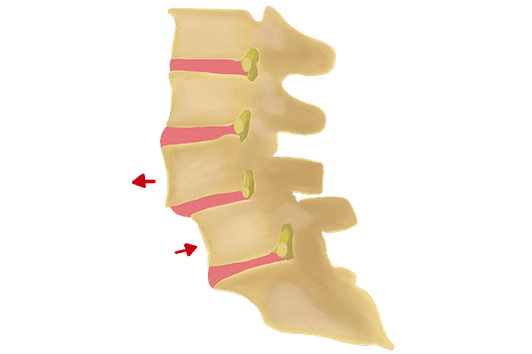Segmental Instability
UNDERSTANDING THE SYMPTOMS, CAUSES AND TREATMENTS
Understanding Segmental Instability
In order to truly understand what segmental instability is in the spine, it is important to understand spinal anatomy. The spine is made up of bones, discs, soft tissues, and nerves. There are 7 cervical bones, 12 thoracic and 5 lumbar vertebral bodies which are circular bones stacked on top of one another allowing your spine to move smoothly.
Each level of your spine functions as a three-joint complex: two facet joints and an intervertebral disc. The three complexes function as a tripod to create stability, supporting the weight above each level and during motion. Segmental instability refers to hypermobility or greater than normal range of motion between two vertebral motion segments. This condition often develops when a particular disc or facet joint degenerates to the point that it can no longer support the weight of the body through that segment of the spine.The most common location that we see segmental instability is in the lumbar spine, especially as someone flexes forward and backwards. Causes include spondylolysis, and/or degeneration of the intervertebral disc or facet joints. Spondylolisthesis refers to the forward slippage of one vertebral body over another which ultimately leads to segmental instability.


Symptoms
Symptoms depend on the severity and location of the spinal instability. Symptoms can include pain, discomfort, stiffness, or muscle spasms in the low back. Symptoms of radiculopathy may appear including numbness, tingling, pain, or weakness in the legs. If the slippage is severe and causes detrimental pressure on the spinal nerves you may develop cauda equina syndrome. These symptoms may include loss of bowel or bladder control, urinary urgency, saddle anesthesia meaning numbness around the groin, difficulty with balance or walking. Cauda equina is a spinal emergency and if you are experiencing these symptoms seek immediate evaluation.
When to Seek Treatment
If you’re noticing symptoms associated with Segmental Instability and suspect a spinal issue, it’s crucial to consider consulting a board-certified spinal specialist. Reach out promptly to a certified spine surgeon for an accurate diagnosis and timely treatment. Early intervention can significantly improve your overall well-being and provide a broader range of treatment options, which may decrease as symptoms persist. The key to a successful and speedy recovery lies in addressing the root of the pain with your spine specialist as soon as symptoms arise.
While many people experience day-to-day back or neck pain, dismissing it as soreness, this may not be the case for everyone. If your pain persists for more than 10 days, it should be taken more seriously. Evaluate such prolonged pain with a spine surgeon to identify the root issue and determine the appropriate treatment. Additionally, be attentive to other signs related to back or neck pain that should not be ignored, including pain accompanied by fever, pain associated with loss of bladder control, and weakness/tingling/numbness in your arms or legs.
It’s important to note that these are general guidelines based on our expertise in spine care over the past three decades, recognizing that each patient’s symptoms may be unique.


Common Causes
Segmental Instability of the spine is an abnormal amount of motion, hypermobility, across two vertebral body sections. This hypermobility can be when one vertebral body shifts forward, shifts backwards, or sideways causing an abnormal spinal alignment. One of the most common forms of segmental instability is spondylolisthesis, or a forward slippage of one vertebra in relation to the vertebra below. Spondylolisthesis commonly occurs secondary to spondylolysis, or a fracture of the pars interarticularis (isthmic spondylolysis).
There are many other causes of segmental instability of the spine. Some include degeneration of the intervertebral disc or facet joints. As mentioned above, the disc and facet joints are the building blocks of each motion segment. Another risk factor of segmental instability is a weakened or deconditioned core, which include the superficial and deep muscles of the abdomen and back. If these muscles which support the spine are weakened it is at risk for instability. Although it is rare, instability can also be seen in the cervical or thoracic spine after a severe trauma such as a car accident.
Diagnosing Segmental Instability
Although when evaluating patients we obtain a detailed medical history and perform a comprehensive examination which increases our suspicion for segmental instability it is not diagnosed without imaging. Typical x-rays include weight bearing AP, lateral, flexion and extension views. Sometimes instability is obvious while other times it is not, which is why flexion and extension x-rays are vital. By having a patient bend forward and backwards we are assessing for spinal instability in motion.


Treatment Options
Initial treatment for segmental instability consists of non-surgical treatment modalities including spine-specialized physical therapy, anti-inflammatory medications, core strengthening, low impact exercise, manual massage, and trigger point dry needling. Surgical intervention may be recommended if you fail non-surgical treatments, develop progressive neurologic deficit, have severe spinal instability, or intractable pain. The goal of surgery is to stabilize the unstable spinal segment which is best achieved through a fusion procedure. The fusion would weld two bones together to prevent further motion or slippage and improve overall alignment and disc height.

